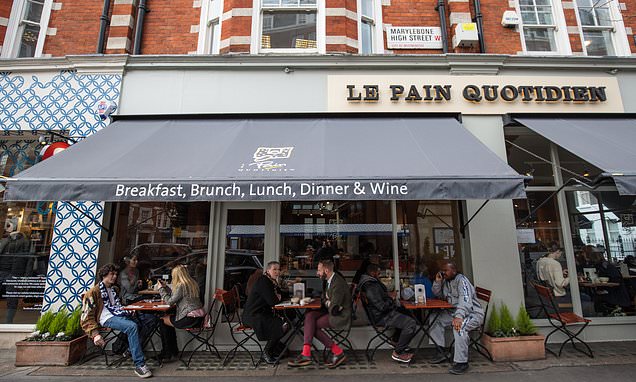High Street bakery chain Le Pain Quotidien closes all of its branches except ONE as it collapses into administration
- The collapse could see the loss of 250 jobs as only the site in St Pancras remains
High Street bakery chain Le Pain Quotidien has been forced to close all of its branches except one after collapsing into administration.
The Belgian coffee chain which has eight branches across London has closed all sites except for the cafe at St Pancras in another hit for the hospitality sector – and a continuation of the fall of the British high street.
The fall of Pain Quotidien could see the loss of 250 jobs, according to The Caterer.
A note has reportedly been left outside one of the branches which says: ‘The affairs business and property of the Bruncho UK Limited (trading as Le Pain Quotidien) are being managed by the Joint Administrators, Sarah Rayment and Philip Dakin of Kroll Advisory.’
Sarah Rayment, global co-head of restructuring at Kroll, told CityAM: ‘Pressures on parts of the hospitality and casual dining sector have been well highlighted.
‘Brunchco UK Limited which is predominantly located in London has suffered from reduced revenues as a result of decreased footfall in the capital, high rents and increased wage costs.
‘As part of the next steps of the insolvency, we will be looking to realise value from the company’s leasehold interests and other assets.’
MailOnline has contacted Le Pain Quotidien for comment.
High Street bakery chain Le Pain Quotidien has been forced to close all of its branches except one after collapsing into administration (stock image)
In 2020, MailOnline reported on Le Pain Quotidien being on the brink of collapse.
Today’s update comes after figures published by the British Retail Consortium (BRC) lay bare the scale of the decline of Britain’s high streets in the North compared to the South, with the highest number of vacant stores in the North East (17.5 per cent), Wales (16.5 per cent) and the West Midlands (15.8 per cent).
The lowest vacancy rates are in London (11.1 per cent), the South East (11.3 per cent) and the East (12.8 per cent).
The overall vacancy rate in the first three months of this year stands at 13.8 per cent – the same as the previous quarter, the BRC said.
Towns such as Wigan have seen major high street chains including Marks & Spencer, Debenhams, BHS, H&M and Next all shutter outlets in recent years. In the North East, Hartlepool, Newcastle and South Shields have all suffered, while Stockton-on-Tees in County Durham had a 20 per cent vacancy rate in 2019 although this is now falling.
But shopping areas in the South have also been dealt a hammer-blow by the cost of living crisis – such as Margate in Kent, where some empty stores have been turned into classrooms.
London’s Oxford Street has also been hurt by economic hits such as the coronavirus crisis, with major brands including Topshop, Debenhams and House of Fraser all closing branches.
Many vacancies in the capital’s West End are now filled with American candy stores on short term leases.
More follows.
Source: Read Full Article


